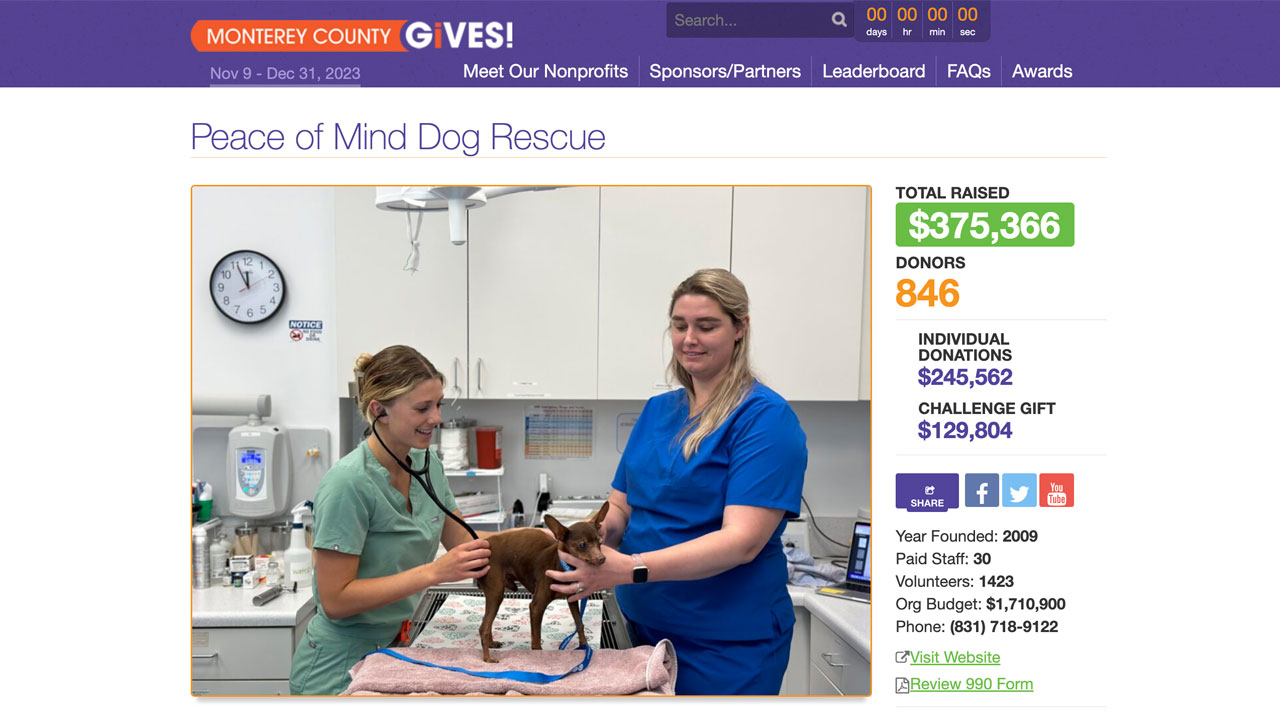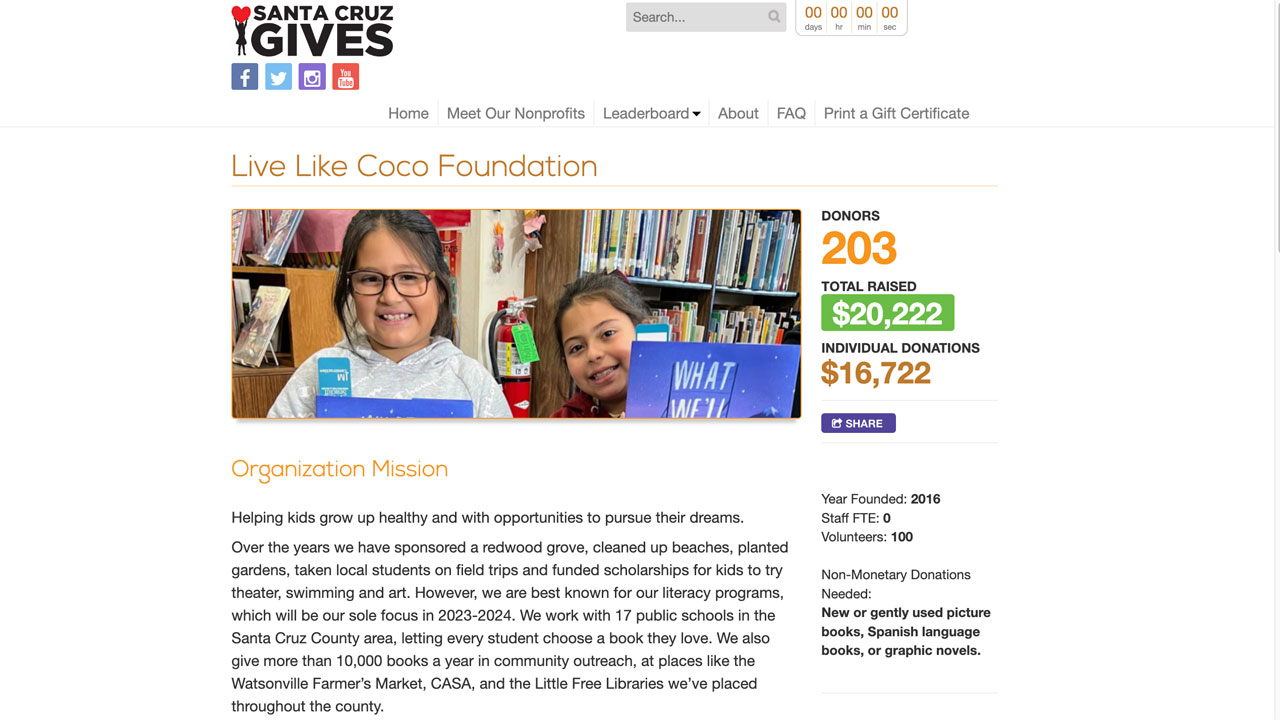How Monterey County and Santa Cruz County ‘Give Back’

OlhaBEK Shutterstock.com
Over the past few years, many media pundits have opined that philanthropic organizations could become a significant source of financial support for journalism. But in the Monterey Bay region, two venerable media companies prove the opposite, using their newspapers to raise money—lots of money—for local nonprofits.
From mid-November through December, Monterey County Gives and Santa Cruz Gives leverage holiday goodwill and the urgency of an end-of-year deadline to encourage thousands of folks to donate millions to charity.
Since there’s nothing more dear to our hearts at California Local than motivating average citizens to engage with their communities, we wanted to learn more about these successful fundraisers sponsored by two members of the California Local Media Alliance.
Philanthropy on the Monterey Peninsula
Back in 2000, Monterey County Weekly founder Bradley Zeve started a donor-advised fund called the Weekly Community Fund with the Community Foundation for Monterey County. By then his newspaper had already been around for a dozen years and Zeve was looking to “create change through charity.” The fund would focus on one organization and publish various stories while raising as much money as they could for the group. “But over time it seemed rather narrow to just pick one group,” Zeve explains.
In 2009, Zeve teamed up with both the Community Foundation for Monterey County and the Monterey Peninsula Foundation to launch Monterey County Gives. Since then, Zeve says, “We’ve collectively raised and donated $56 million.”
This year, Zeve was daunted by the task of beating last year’s record $11.2 million haul. “Ten years ago, in 2013, is when we first broke a million,” Zeve recalls. “And we just broke another record for the amount raised and the number of donors.” The new benchmarks: $11.8 million raised, with close to 8,000 donors participating.
“I just try to envision and imagine what would happen if we had 10,000 donors. Or 12,000. It’s still just a drop in the bucket for the number of people who could give,” Zeve muses.
“What’s beautiful about this is it’s kind of a democratization of philanthropy,” Zeve says. “You have $100 you want to contribute, and you can do this in five minutes and give to 10 different groups.”
In addition to raising money, Monterey County Gives also raises awareness. “There’s something about this program that’s helping bring some focus and concentration to the whole boatload of nonprofits that are doing community work. A lot of people just really love Gives for that purpose.”
To help build more awareness, MC Weekly’s editorial team writes about groups that seem worthy of extra attention. “That really is powerful because then we’re picking organizations that we know are making a difference,” Zeve says.

The Monterey County Gives website also lets donors do a little journalistic exploration of their own, Zeve says. All participants are required to post their most recent IRS Form 990 online. “This was a way to increase accountability from the nonprofit community,” Zeve explains. “Who actually spends time looking at those other than journalists or grantors? And from my perspective, when we select the nonprofits, the 990s are a very critical part that reveals how they operate their organization.”
In addition to providing details on how much each group raised (amounts ranged this year from $1,660 to $375,366) and the total number of donors, Monterey County Gives also counts young donors (ages 18-35). Zeve emphasizes that stat because he was inspired by Richard Meeker, whose Portland-based publication, Willamette Week, began its Give!Guide program back in 2004. “The young donors become older donors before you know it,” Zeve says. “And they also become volunteers and board members.”
Zeve’s program has inspired other publishers to start their own giving programs, and he welcomes more companies to join in. “I would encourage every remaining news company to do it,” he says, adding the emphasis in recognition of challenges faced by newspapers. But he cautions, “It doesn’t just happen. It takes work.”
Raising Money from the Redwoods to the Sea
To the north of the Monterey Peninsula, in a smaller and less affluent area, Santa Cruz Gives hews close to Zeve’s format. Active since 2015, Santa Cruz Gives has also surpassed the million-dollar mark in total donations.
Veteran alt-weekly publisher Jeanne Howard describes it as a “giving platform” that uses the media muscle of CEO Dan Pulcrano’s Weeklys media group—which publishes local and regional newspapers including Santa Cruz’s Good Times, the (Watsonville) Pajaronian and the (Scotts Valley) Press Banner—to raise money for local nonprofits. “I just knew we had the promotional power. And we have relationships with the radio stations,” Howard says. “So with my media relationships, I knew I could promote this heavily.”
Howard needed a nonprofit partner to accept donations, and the Volunteer Center of Santa Cruz County stepped up to help. And when Susan True became executive director of Community Foundation Santa Cruz County, that organization also came on board. “Susan True immediately recognized that this is the future of philanthropy,” Howard says.
Other longtime sponsors include Santa Cruz County Bank, the Watsonville-headquartered berry-growing giant Driscoll’s, the Applewood Foundation, and Joe Collins, a local philanthropist.
And then, of course, there are some 1,400 people who collectively raised more than a million dollars this year. (The grand total won’t be official until the second week of January, after all the accounting work is complete.)
As with Monterey County Gives, the minimum donation is $5, and donors tend to spread their resources around. “Last year, someone gave $5 to every group,” Howard recalls.

Other similarities between the two giving platforms include how easy they are to use, and how much information is supplied about the nonprofits and their good works. Howard, who composes the profile pages, says she tries to keep them succinct. “They have a mission and a project,” she says. “I want them to all sound so compelling and yet not put too much information in, because people are impatient and they’re trying to read a lot of them.”
Both Monterey County Gives and Santa Cruz Gives offer donors a wide range of potential beneficiaries. “We try to cover the county geographically; we try to choose small, medium and large nonprofit organizations; we try to cover a diverse set of needs,” Howard explains. “And then we try to have some emerging nonprofits.”
This year, two small, fairly new groups attracted the biggest number of donors. At the top, with 203 donors, was the Live Like Coco Foundation, which gives away books to students at 17 public schools in the area; in second place,with 172 donors, was the Amah Mutsun Land Trust, which provides Indigenous leadership in conservation.
“Neither of these have big staffs, and that’s why they’re impressive. They show what can be done with Santa Cruz Gives. We tell people ‘we expect you to work it,’” Howard says. “I like to say that the platform of Santa Cruz Gives is like a wave, and the nonprofit has to surf it.”
Just as important as the total money raised and the number of donors is the age of those who give. “The nonprofits are telling us there are a high number of new donors. That’s such a big deal, just like getting new customers,” Howard says. “The lifeblood of a nonprofit is new donors, and they’re hard to get. And because this platform is modern and easy, they’re attracting younger donors. And those donors turn into volunteers.”
Howard believes that the importance of volunteer work is overlooked. “The public knows the business landscape. They know government does all these things—it’s always in the news.” But they don’t always understand the importance of volunteerism. “This would be a dystopia if we didn’t have all these nonprofits,” she says. Without groups like Save Our Shores and the SPCA, she adds, only partly joking, “I think we’d have more cigarette butts on the beach than sand. There’d be dogs and cats running everywhere!”
It’s Okay to Give Now
Though the donation period is over and the websites are no longer collecting donations, both remain visible so would-be donors and volunteers can learn more about all the groups and ponder where to expend their time and money.
And it’s also not too early for nonprofit groups in both counties to begin planning their “Big Ideas” for 2024 and to get ready to apply to the programs in the summer. For more information, check the FAQ pages for both Monterey County Gives and Santa Cruz Gives.
Long form articles which explain how something works, or provide context or background information about a current issue or topic.